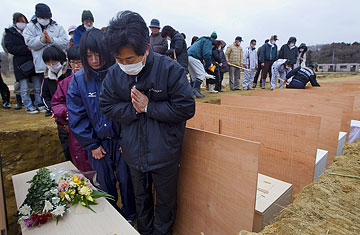
Families and relatives of the dead visit a temporary burial ground on March 25, 2011, in Higashimatsushima, Japan
In Higashimatsushima, hollows were dug in the muddied field of a former recycling center. In Yamamoto, unceremonious trenches were tunneled in a vegetable patch. In Minami Sanriku, once a quiet fishing village, tracts of forest have been razed to expose enough bare land for a makeshift cemetery that will accommodate its share of the 11,000 confirmed dead in the three weeks since an earthquake and tsunami struck Japan's northeast coast.
As Japanese towns pitched into near nonexistence by the convulsions of earth and sea collect what dead can be found, they are also holding the first mass burials in local memory. From the silenced shore now come the sounds of heavy machinery scraping out wide ditches that will receive, at least temporarily, the mounting backlog of bodies. The national custom of cremation — 99.9% of the Japanese who passed on in 2009 were cremated, according to the Health Ministry — is unsustainable when faced with the vast human toll. There is not enough kerosene to burn the departed, dry ice to preserve them or petrol to carry them to places less debilitated. Minami Sanriku, which has likely lost over half its inhabitants, has the resources to cremate but seven a day. There, as elsewhere, a number of survivors have taken their dead home, unwilling to return them to the ground.
In a manifold catastrophe that ruined the coast's most solid structures, Japan's delicate mortuary rites could not have hoped to endure. By tradition, the deceased receives an elaborate wake and funeral ceremony. Before the family and in the Buddhist way, the body is surrendered to the furnace for cremation. It is not burned entirely to ash, but reduced to small bone fragments, which the relatives, in pairs, pick out with chopsticks and transfer gently to a waiting urn. The foot bone is the first to be contained. The last, called the "Adam's apple" in Japanese, is a chip of the upper spine whose shape suggests a Buddha seated in meditation. The urn will often spend a month in the home before being interred in a family grave. As land becomes scarcer and relations less reliable for the upkeep of plots, people's remains are increasingly gifted to the wind.
That Japan will not but burn its dead is a lesson in the fickleness of tradition. Just as full-body burial is now unseemly — and, in parts of the country, banned — so was cremation once controversial. The 17th century Confucian scholar Kaibara Ekken considered the long-standing practice of incinerating the deceased more shameful than "abandoning the body in the fields and making it food for the foxes and badgers." During the late–19th century Meiji period, in a wave of nationalist vigor, it came under decisive attack. Cremation, tied to Buddhist influence and by which the body of Siddhartha Gautama himself is said to have been disposed, was called foreign and barbaric and nationally outlawed. Opponents of the interdict launched a noisy protest. The group tried to shame the government, accusing it of exposing people to decaying corpses and squandering valuable land.
Their campaign worked: in 1875, less than two years after it was passed, the ban was lifted. Improved crematoria with ventilation systems and smokestacks took shape. Suddenly the practice seemed modern, and cremation was championed as a product of postindustrial Japan by the very Meiji establishment, an urban elite taken with its own education and hygiene, that had forbidden it. "It is remarkable how quick custom can change in a country," says Durham University professor Douglas J. Davies, co-editor of the Encyclopedia of Cremation. In 1930, more than half of Japan's dead were still buried whole. By 1940, in a country ravaged by war, cremation had overtaken burial in the cities. Miyagi and Iwate, two of the prefectures worst stricken by last month's cataclysms, only made the transition to body burning between 1960 and 1970.
But even for survivors of the earthquake and tsunami who can recall a time of ritual interment, mass burial is a thing beyond belief. Most of the earthly pits that now follow the curve of the northeastern coast are so cavernous as to hold thousands of strangers. They are filled with simple, interchangeable coffins and sometimes just partitions of plywood sheets and plastic tarps. The government has sworn to exhume all of the remains for proper cremation in no more than two years and already some furnaces are smoldering again, forestalling further rushed funerals. The ones they cannot help are the 17,000 still missing, for whom the rubble or calmed water may act as a final resting place.
